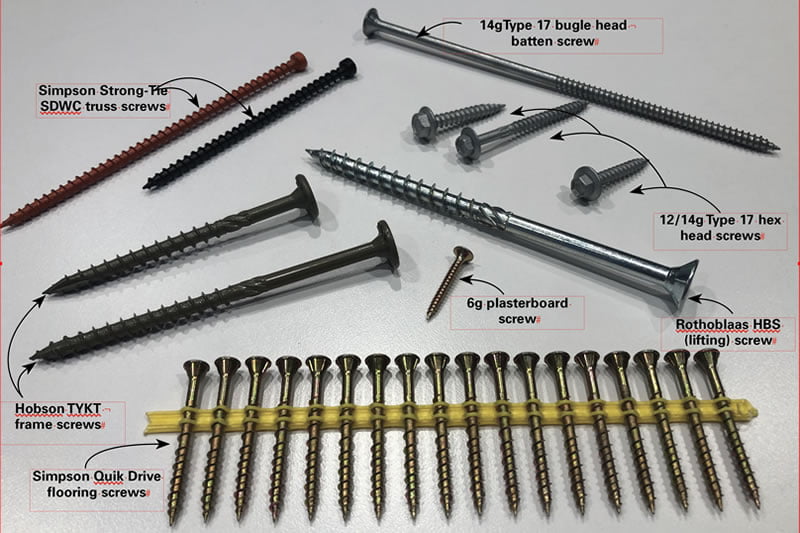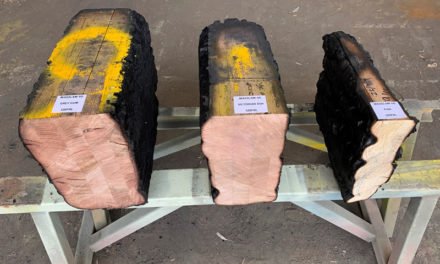Things haven’t been the best lately, but at least construction connections are improving. By George Dolezal, principal engineer, Meyer Timber.
2020 is behind us and what a year it was. The past year is one that will go down in history as one of the most-remembered years for those of us who’ve lived through it. Hopefully the worst is over and we can start to slowly return to a semblance of normality whilst learning from the experiences and changes we had to make. As the title says – It’s all a bit screwy.
But this does not refer to the year we have just had, although it fits the bill perfectly. Screws are being used more and more on construction sites for timber connections, so it is worthwhile spending some time to review what is available. Reasons for the uptake of screwed connections include increased design capacities, range of uses, and most of all the prevalence of machinery (collated screw guns and cordless impact drivers) to site install them easily. This is in preference to hand-hammered nails or bolts, which have historically been the main fasteners used for timber connections.
If we start with design capacities, Table 1 (below) shows the difference in the base lateral capacity for a variety of common nails, screws, and bolts to connect two 45mm LVL boards together (assuming no reduction factors). You can see that only half the number of 12g screws are required to replace 3.75mm diameter nails, and this gets better when the screw gauge increases or nail diameter reduces. The M10 bolt has the highest capacity in the table, although it comes with the need to pre-drill the hole before installing.
Fewer connections can mean a faster install, especially if compared to hand nailing. This becomes beneficial in areas such as floor systems which may have a large number of joist hangers. Screw fixing isn’t only quicker, positive fixing and clamping of the bracket will reduce the potential for floor squeak.
| Fastener | JD4 Lateral Capacity (Qk) |
| 3.15mm Ø nail | 0.8kN |
| 3.75mm Ø nail | 1.1kN |
| 12g screw | 2.5kN |
| 14g screw | 3.1kN |
| M10 bolt | 5.6kN (perp. to grain) |
Table 1 – Lateral capacity of different fasteners
As an aside, fixing brackets with machine-driven nails (unless from a gun which is specifically designed for the purpose, like the Simpson Strong-Tie CCN64) may be very convenient for carpenters, but unfortunately it is the most error-ridden as well. So much so that this method of fixing is not permitted in Queensland anymore and it is only a matter of time before the rest of the states follow suit. The best alternative in this case is a hex-head screw for reasons pointed out earlier.
There are more screws becoming available that don’t meet the requirements of AS 1720.1 in terms of being a standard gauge and manufactured in accordance with the AS 3566 series of standards. These can still be used, but the manufacturer will need to be consulted to provide design values that can be used with AS 1720.1 and data may extend to different spacing and end/edge distance rules as well.
The biggest change in screw technology has probably been the range of uses. The most common screw in timber construction has been the 14g Type 17 Bugle Head batten screw, which still has its place, but advancements mean you get different benefits from other properties:
- Large washer head screws provide good clamping forces along with high head pull-through values, making them ideal for withdrawal applications like Hobson TYKT or Simpson Strong-Tie SDWS frame screws.
- Fully threaded screws resist forces along the length of the screw, meaning they can have a very small head to embed into the timber. This is useful when tying down trusses or rafters with screws such as Simpson Strong-Tie SDWC screws.
- Screws can allow for fixity in two lateral directions but movement in the vertical direction, for use in shear transfer of trusses to bracing walls and lateral restraint of non-loadbearing walls.
- Certified lifting systems incorporating screws and lifting hooks such as the Rothoblaas WASP hooks and HBS/VGS screws are available to simplify the installation of pre-fabricated timber-based floor and wall cassettes.
- Dual pitch screws are becoming more common for uses such as decking installation. One thread pitch goes into the joists and a smaller pitch is for the decking board to facilitate clamping.
- Larger screws often have different points (square, saw tooth or chisel) and can have wings or knurls along the length to help with installation.
- Roofing screws are now available with a universal tip that allows for fixing into both timber battens and steel purlins.
You can also use screws for things other than joining. For larger timber members a method of failure can be due to bearing at supports. By using fully threaded screws into the timber above the bearing point the load is transferred throughout the cross section rather than concentrating it at the support edge. Fully threaded screws can also be used to prevent timber from splitting at changes in cross section, such as deck set downs.
Positive clamping force is an important benefit for screws which has seen them being used more in high volume applications like flooring or decking. Screwing floor sheeting down reduces the risk of floor squeak significantly, but this has only become viable with the emergence of tools such as collated screw guns or the Simpson Quik Drive system. Cordless drills helped volume of screws increase, but the cordless impact driver has magnified this. You will be hard-pressed to find a carpenter on site who does not have a cordless impact driver as well as a nail gun. And add to this that if something goes wrong it is simple to remove the screw and re-install if needed; it makes them appealing for connecting to timber.
The humble screw has come a long way in a short time. The days of 6g plasterboard screws, 8g and 10g countersunk head screws, 12g roofing screws and 14g batten screws being all you can get for timber connections are far behind us. You can now buy specialised screws from manufacturers such as Simpson, Rothoblaas, Wurth and Spax. These screws can be up to 13mm diameter and over 1200mm long (used for fixing together large mass timber panels). As always, there is nothing wrong with using any screw as long as, if they are outside the code, they have clear design capacities and technical data to allow use in accordance with Australian Timber Design codes such as AS 1720.1 and the AS 1684 series. The construction industry is embracing the technology and is getting more screwed by the day – in a good way. (Sorry, but I had to do it…)
For more information on this topic, contact George Dolezal via email at GeorgeD@meyertimber.com.au
Image: A collection of different screws available for timber connections.












